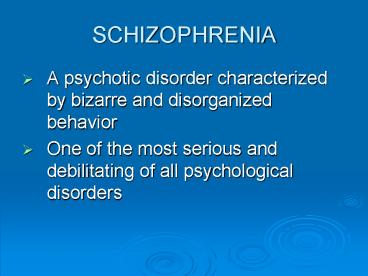SCHIZOPHRENIA - PowerPoint PPT Presentation
Title:
SCHIZOPHRENIA
Description:
... jump from topic to topic Neologisms - make up words Incoherence - word salad Clanging - rhyming Disorganized Behavior Disheveled appearance, ... – PowerPoint PPT presentation
Number of Views:100
Avg rating:3.0/5.0
Title: SCHIZOPHRENIA
1
SCHIZOPHRENIA
- A psychotic disorder characterized by bizarre and
disorganized behavior - One of the most serious and debilitating of all
psychological disorders
2
DSM-IV-TR CRITERIA FOR SCHIZOPHRENIA
- 2 or more for at least a 1-month period
- 1. Delusions
- 2. Hallucinations
- 3. Disorganized speech
- 4. Grossly disorganized or catatonic behavior
- 5. Negative symptoms flat affect,
alogia,avolition
3
CRITERIA FOR SCHIZOPHRENIA
- B. Social/Occupational Dysfunction
- C. Duration continuous signs of disturbance for
at least 6 months, including at least 1 month of
active phase sx and periods of prodromal or
residual sx. - D. R/O Schizoaffective Disorder, Mood Disorders,
the effects of a substance, and general medical
conditions.
4
2 Categories of Symptoms
- Positive Symptoms -behavioral excesses/ problems
normal people do not experience - Better treatment outcomes
- Respond to medication
- Negative Symptoms - behavioral deficits normal
people do experience - More resistant to medication
5
Positive Symptoms
- Hallucinations
- Delusions
- Disorganized Speech
- Disorganized Behavior
6
Hallucinations
- Sensory experience that is a product of ones
mind doesnt exist in the outside world - Modalities Auditory, Visual, Tactile,
- Olfactory, Gustatory, Somatic
- Auditory most common
- Distressing, give commands, noise in their head
7
Delusions
- Erroneous beliefs that cant be influenced or
corrected by reason or contradictory evidence - Themes Persecutory, Referential,
- Grandiose, broadcasting
8
Disorganized Thought Speech
- Statements/thoughts arent logically connected to
each other content often makes no sense - Tangential - loose associations
- Derailment - get off track
- Flight of ideas - jump from topic to topic
- Neologisms - make up words
- Incoherence - word salad
- Clanging - rhyming
9
Disorganized Behavior
- Disheveled appearance, unusual dress, basic
hygiene neglected - Inappropriate affect - doesnt fit w/ the
situation, childlike silliness - Agitation unpredictable, untriggered
- Posturing inappropriate, bizarre movements
- Catatonia lack of response to environment,
stupor (complete unawareness), rigid posturing,
negativism (resistant to instructions)
10
Negative Symptoms
- Poverty of speech
- Flat affect
- Avolition
- Social isolation
- Motor retardation
- Anhedonia
11
Alogia
- Poverty of speech ? decrease in speech fluency
and productivity - Severe reduction in speech e.g. brief replies
- Absence of speech
12
Flat Affect
- Severe reduction in or absence of emotional
responses to environment. - Examples
- Face is unresponsive or lacks expression
- Poor eye contact
- Reduced body language
- Diminished range of emotional expression
13
Avolition
- Lack of will/motivation
- Inability to initiate or persist at tasks
- Little interest in social or work activities
14
SUBTYPES OF SCHIZOPHRENIA
- Paranoid Schizophrenia
- Disorganized Schizophrenia
- Catatonic Schizophrenia
- Undifferentiated Schizophrenia
15
SCHIZOPHRENIA, PARANOID TYPE
- Most common subtype
- Presence of prominent delusions (persecutory most
common) and hallucinations (usually auditory) - Delusions and hallucinations revolve around a
central theme - Lack of catatonic sx, disorganized speech or
behavior no negative symptoms present
16
SCHIZOPHRENIA, DISORGANIZED TYPE
- Disorganized speech
- Disorganized behavior
- Flat or inappropriate affect
- No evidence of catatonia
17
SCHIZOPHRENIA, CATATONIC TYPE
- Rare form of schizophrenia
- Catatonic symptoms (motor related) 2 or more
- Echolalia mimic verbalizations
- Echopraxia mirror motor movements
18
SCHIZOPHRENIA, UNDIFFERENTIATED TYPE
- Dont fit into any of the other 3 categories
- Display a mix of symptoms
19
Facts Figures
- Prevalence 1 in 100 people approx. 4 million in
U.S. - Onset men mid 20s (18-25) women late 20s
(25-35) - Gender women have a more favorable course
- Prognosis debilitating, long-term disorder
chronic course complete remission is rare - Living situation 50 live with or rely on
family many live in residential treatment
facilities - High suicide rates 10-20
20
Facts and Figures
- Large percentage of the homeless population
(10-20) - High rates of substance abuse 80-90 use
nicotine - More likely to be born in Jan, Feb, March
- Strong genetic component MZ twins 48 DZ twins
17
21
Biological Theories of Schizophrenia
- Genetic theories
- Structural brain abnormalities
- Birth complications
- Prenatal viral exposure
- Elevated levels of D, NE, 5HT
- Lower levels of GABA Glutamate
22
Treating Schizophrenia
- Psychoeducation for patient and family
- Consistent medication management traditional
antipsychotics vs. atypical antipsychotics - Supportive therapy
- Intensive psychosocial interventions intensive
case management, outpatient treatment programs,
CBT, skills-based training































